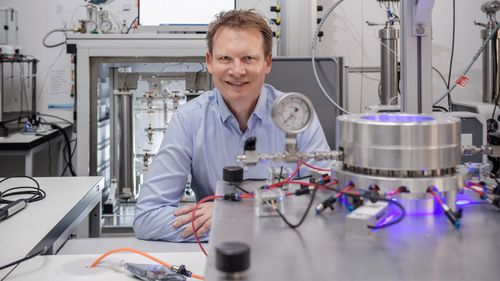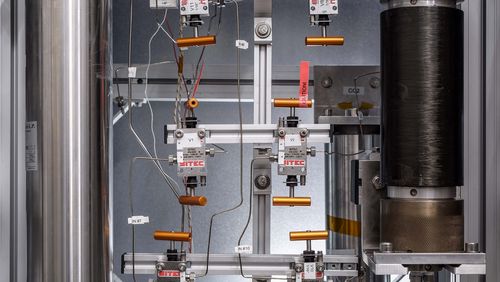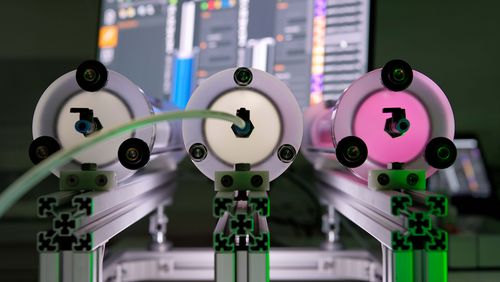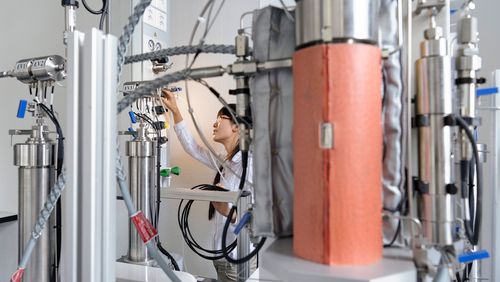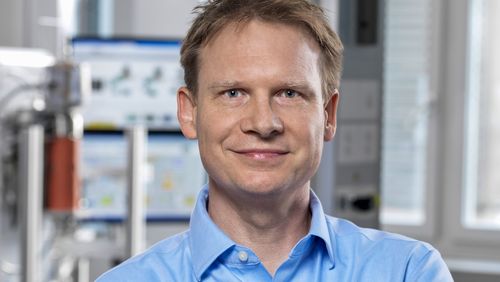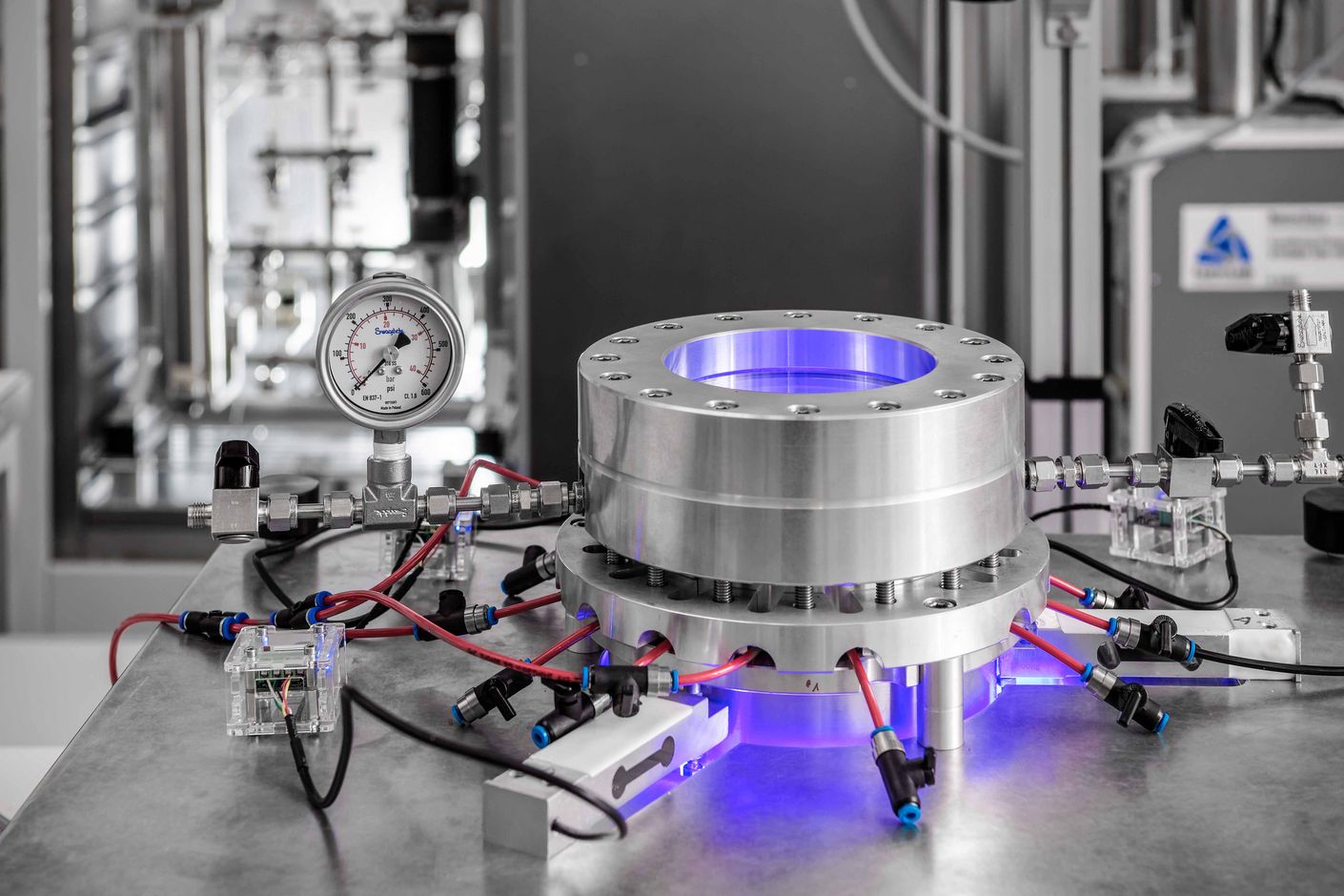
Earth's powerful core
The interior of the earth harbours massive amounts of energy. But harnessing it is complex: deep drilling is expensive, rock layers are unstable or impermeable, while the lucrative hot fluid streams flow too deep to access or their location is a mystery. Geophysicist Martin O. Saar has now developed an innovative method to tap into the energy in the earth’s crust—and capture the greenhouse gas carbon dioxide at the same time.
The cylindrical piece of rock, a drilled sample measuring just a few centimetres, is wrapped in a thick, insulating outer shell. Leading into the cylinder are several thin metallic tubes that conduct pressure, heat or fluids into the rock. The aim is to place a sustained stress on the rock for days, effectively simulating the conditions at 10 kilometres below the surface of the earth; a computer then records in minute detail how the fluids and the rock react. The testing unit is called a “reactive transport press” and is one of three units in the lab run by Professor Martin O. Saar, Werner Siemens Foundation Endowed Chair and head of Geothermal Energy and Geofluids, a group of nearly 30 researchers at ETH Zurich. After five years of preparation, the lab with the descriptive name Geosystem Reactive Transport (GREAT) Visualization Lab is now fully equipped. Indeed, the research findings from the lab have already generated doctoral theses and many of the 29 scientific papers that Saar’s group has published in leading journals over the past nine months.
Studying water flows
Although the earth’s crust consists mainly of hard rock, the deep geothermal energy experiments at the lab are focused on fluids and flows—indeed, it is flow resistance in rock that poses the greatest challenge to Saar and his team. To learn more, the researchers simulate and calculate in the lab what normally occurs deep down in the darkness below the earth’s surface. For instance, they use a 3D printer to create transparent, highly accurate models of the fracture patterns in the rock. A fluid—saltwater, for instance, with special markers added—is then pressed through the cracks; the markers are designed to glow in laser light, enabling them to be photographed by the three high-resolution cameras that capture up to 2 000 images per second. Because the cameras work simultaneously, the researchers can map a vector field of the fluid’s flow velocity and then calculate it on their supercomputer.
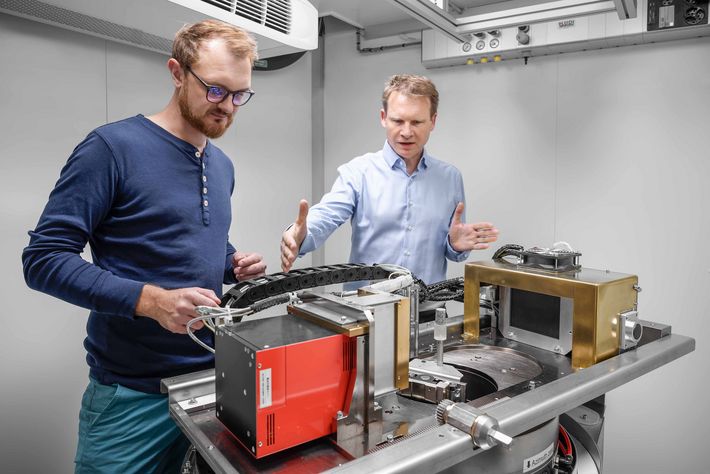
3D visualisations
Lead-clad walls shield the newest part of the lab where Saar’s team conduct their reactive transport experiments with machines normally used to scan human bodies: using X-ray computer tomography, they create 3D visualisations of rock weathering and mineral precipitation as they are commonly encountered when tapping into deep geothermal energy. The 3D printer can also print the visualisations created by the CT scans; the resulting models are then used in the laser-light experiments. “Thanks to the GREAT Visualization Lab, we can create detailed models of the reactive transport of geofluids. It’s unique in the world,” says Martin O. Saar. To create the models, the researchers develop customised computer programs; they also have the capability to test the computer simulations and recalibrate them to the scale of actual geological reservoirs. Saar says this would be out of the question in a standard lab experiment.
First study in Switzerland
One part of the research team conducts field experiments—more precisely: underground experiments—to explore the conditions. To date, explorations have been conducted in Ethiopia and Mongolia and are currently ongoing in the Swiss canton of Aargau, where literal hotspots have been discovered: areas in the earth’s crust where hot water flows relatively close to the earth’s surface—roughly one to two kilometres underground. There, the researchers use an electromagnetic geophysical method known as magnetotellurics to measure underground electric currents. This delivers information on how well the porous cavities in the rock are connected, what kind of fluid is flowing underground and where zones with good conductivity are located. “The first study in Aargau is promising. But it isn’t easy to interpret the electromagnetic waves in heavily populated areas,” admits Saar. For their measurements, the team use electromagnetic fields that arise through solar winds or lightning during massive thunder-storms at the equator—phenomena so strong that they can be measured in Switzerland. On the downside, electric mains in populated areas often interfere with the measurements. Here, too, Saar and his team have found an innovative solution: in collaboration with another ETH research group, they developed a new software program that calculates and partially eliminates electromagnetic noise in the atmosphere.
Carbon dioxide sinks
Martin O. Saar and his team aim to go beyond researching basic principles: they want to discover efficient and ecological applications for their findings. One such application is the subject of Saar’s largest project that explores using CO2 as both a geofluid and a conduit. In a closed-loop cycle, carbon dioxide is channelled under-ground and used to transport heat back up to the surface. Ten years of research have been invested in the project, three in collaboration with the Siemens Group. Now, the chance of running the first practical test is a real possibility. “Reducing CO2 emissions is one of the world’s most important climate goals,” says Saar. Currently, the researchers are negotiating with the managers of a carbon dioxide reservoir in Canada where 350 000 tons of carbon dioxide emitted from a coal-fired power plant have already been stored at a depth of 3.2 kilometres. The reservoir would be suitable as the first testing site for Saar’s new technology. In comparison to water, Saar believes using CO2 as a geofluid could double the efficiency of geothermal power plants. Moreover, the method would be ecological, as the carbon dioxide would remain trapped underground. Saar is convinced: “We’ll need to use these technologies in future if we want to stop global warming yet continue to produce electricity.”
Text: Sabine Witt
Photos: Felix Wey



